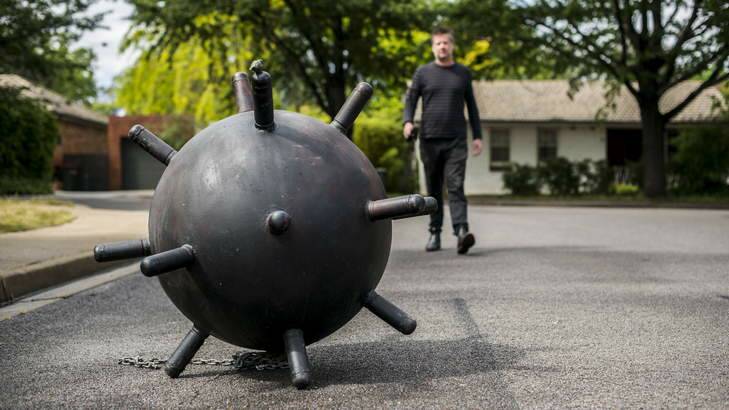Quite unremarkable-looking Rennie Street in famously average Downer is about to have a dramatic transformation that will make it, briefly (just for this weekend), the most exotic street in Canberra.
Subscribe now for unlimited access.
or signup to continue reading
It is going to be the site of the city's first ever Sculpture in the Street exhibition in which every front garden (and at least one roof and at least one tree) in the stubby little street is going to be decorated with several works of art contributed by 32 Canberra and regional artists. And there will be some overflow of artworks on to an adjoining street where, for example, there will be a life-sized sculpture of a horse grazing on the nature strip.

On Tuesday morning, leafy but modest working-class Rennie Street (not a McMansion to be seen) was still for the moment looking almost its normal self except that street resident and exhibition organiser, sculptor Stephen Harrison, was beginning the transformation by hauling one of his own works into place.
''It's not a real one, is it?'' a concerned passer-by wondered when she saw Harrison's sinister-looking replica of a World War II sea mine ''floating'' on the Rennie Street kerb.

As reported some weeks ago, Harrison quite recently posed the mine on the beach at Bermagui during Bermagui's famous Sculpture on the Edge (edge of the sea, edge of the cliff) festival where his Sculpture on the Street idea was born. Anxious Bermagui locals called police and coastguards and the local press feasted on the stir it caused.
Since then Harrison, who likes to make explosive-looking contraptions, has been amused to discover Rennie Street is named after Edward Henry Rennie (1852-1927) ''who at one time was South Australia's government analyst and inspector of explosives … very apt for the explosive sculptures I've been making. We'll have a little shrine to Mr Rennie (with bombs around him) at the exhibition.''
Even though it is only a little street, lots of us will marvel that Harrison has got such co-operation from everyone in it, from all his neighbours, for his idea. Here! In disruption-phobic suburban Canberra! How many of us live in a street that amenable, that amiable? Certainly one can't imagine any of the city's snob-infested streets agreeing to it. Mugga Way? No way!
''But I've lived here for about 20 years so I've got to know the people. So it was just a matter [he laughs to remember it] of going to them and saying 'This is my idea. Do you mind? Is it OK?' and they all said 'Yes, sure. Why not?' I didn't have a single knockback, but if I'd had even one, then I wouldn't have gone ahead because it needed to be the whole street if it was going to work.''

And as for finding the artists, well ''it really did take off once the word spread. It just started snowballing. After all there aren't many places in Canberra for people to show their work, and this was a really good opportunity to show things in a really relaxed environment. And we had a site visit so artists could pick their spots. So, for example, one woman said, 'I'm going to hang beaded things from that gumtree over there.'''
He hopes, too, that people who would never set foot in a regular art gallery will roll up to stroll through the informal gallery of leafy, unpretentious Rennie Street.
And although the object of the brief festival is to have lots of fun, Harrison rejoices that it's attracted lots of prizes with, as well as prize packs from the Centenary of Canberra, ''prizes like the Phoenix Bar Prize ($200), the Fat Bastard Who Likes Beer People's Choice Prize ($500), the Green Shed Prize for best sculpture made of recycled material ($200 green money), the Quest Prize for a Damn Good Sculpture ($200) and many more''.
Sculpture in the Street begins its brief life in suburban Downer at 6pm on Friday (with a party, with drinks and nibblies) and then closes on Sunday at 4pm, allowing suburban normality to resume.
And, while talking of fleeting displays of art … We've had Remembrance Day this week and just in case you've not seen them yet we point you, online, to the astonishing pictures of the silhouettes recently etched into the sand of a Normandy beach. Just Google ''Normandy beach silhouettes''.
British artists Jamie Wardley and Andy Moss went to the beach with rakes and stencils and 60 volunteers to etch 9000 human silhouettes. Their necessarily temporary artwork The Fallen 9000 was meant to remind us of the civilians, Germans and Allied forces who died during the D-Day beach landings at Arromanches on June 6, 1944, during World War II. As the 60 laboured, 500 locals and visitors joined in the poignant work. The artwork lasted only a few hours until the tide came in and washed it away. When you go and look at the pictures you'll see one in which the doomed silhouettes, still visible, are already beneath the shallow waters of the incoming sea.

